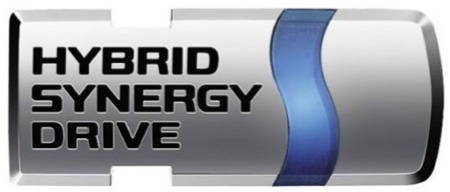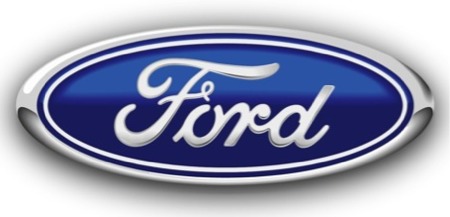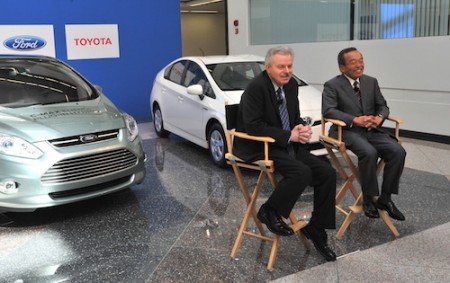Analysis: Ford & Toyota’s New “Hybrid Synergy”
- August 22, 2011
- Auto News & Reviews, Ford, Toyota
- Posted by Dave Sullivan
- Comments Off on Analysis: Ford & Toyota’s New “Hybrid Synergy”
If you think back, GM developed the 2 Mode Hybrid system in collaboration with BMW and Daimler-Chrysler. Chrysler had about a two month run of Durango and Aspen hybrids. If you see one on the road you might consider it to be an exotic due to how rare it is. BMW has a hybrid system in their X6, but it is for performance more than fuel economy. Daimler has a RWD hybrid system in the Mercedes-Benz S Class, but the fuel economy hasn’t been anything to make headlines with. While not being much of a success for any party involved in that collaboration, one GM engineer described the 2 Mode hybrid system to me as a “very expensive science project”. What Ford and Toyota teamed up to do today looks to be more than a science experiment.
GM’s system has never been anything to get excited about due to the cost and ho-hum fuel economy gain. Ford can offer more power, fuel economy and capability with the EcoBoost V6 in the F-150 than GM’s 2 Mode system in the Silverado, for far less money. With a hybrid system, it should be less costly than using a combination of techniques, such as aluminum, magnesium, active shutters, etc to help achieve fuel economy targets in trucks. Diesel has been the way to hit fuel economy in trucks for many years, but Ford is looking farther down the road than a Band Aid diesel engine that seems to have more stringent exhaust requirements every year.
Based on the press conference today, it pretty much sounds like Toyota has a RWD hybrid system in development but they need Ford’s sales volume to make it work from a cost perspective. Ford also needs a fuel economy improvement for their light trucks, so the agreement should be mutually beneficial. A 2011 Toyota Sequoia 4WD with the 5.7L V8 is rated by the EPA at 13 mpg city/18 mpg highway, so clearly Toyota is in need of fuel economy improvements as much as anyone. Trucks have an incredible amount of mass to move and city driving can be detrimental to their fuel economy. Ford is already able to achieve up to 23 mpg with the F-150 on the highway, but city mileage is in need of an improvement. Diesel has been the way to hit fuel economy in trucks for many years and some manufacturers will take this route with their light trucks – Ford and Toyota are going another way. Just as everyone said no one would buy a turbocharged V6 F-150, Ford proved naysayers wrong. Expect the same type of success with the fruits of this agreement when a hybrid F-150 debuts. This can also allow Ford to not compromise on durability or capability at the expense of fuel economy. Customers will still want to tow and haul with their trucks and a hybrid system won’t necessarily force Ford to reduce tow ratings or payloads while delivering significantly improved fuel economy.
For the telematics end of things, Ford has clearly shown leadership in this area as a bleeding edge (in the automotive world) technology provider and Toyota looks to gain knowledge, patents, and intellectual property out of this. So, each has something they could gain out of this. Could we see “EnSync” out of this? (Toyota’s Entune and Ford’s Sync) Probably not…as most of the sharing will all be on the back end of things as a way to help influence the SAE to form new standards for all OEMs to adhere to.
Will this be another botched marriage? GM and Fiat failed. Daimler and Chrysler failed. GM and Toyota’s NUMMI plant closed. Could Japanese and American cultures collide? Clearly Derrick Kuzak, Ford group vice president, Global Product Development, and Takeshi Uchiyamada, Toyota executive vice president, Research & Development, had a friendly press conference today but this is just the beginning. Ford had a long history with Mazda and a joint venture with Nissan for the Quest/Villager. Ford also did extensive collaboration with Toyota in the 80s and 90s to share manufacturing expertise with Ford’s former Atlanta plant and Toyota’s plants in Japan. So, out of the Detroit 3, Ford is likely the best suited for working with a Japanese OEM, from a historical perspective. It will be interesting to see how two OEMs, both with family names sitting at or near the top of the management structure take a role in this agreement.
What about Ford’s long-in-tooth Expedition and Navigator? I think that Ford was looking for a silver bullet for the Expedition/Navigator powertrain. They will introduce an EcoBoost V6 in the interim but this may be able to extend the Expedition into another life cycle. With this agreement, Ford is likely to be looking at options for the Expedition since it will no longer have to weigh down their corporate average fuel economy (CAFE).
With the Japanese Yen stuck in an almost-permanently bad place for Toyota for what appears to be the long term, this will help drive their hybrid cost structure down. The battery packs could be assembled here. Ford has their new battery pack assembly capability here, which could be looked at when Ford and Toyota determine the scope of this project. I think it is safe to assume that both parties are interested in localizing assembly to reduce any currency concerns. And Toyota need not worry about quality, as Ford’s quality has improved significantly (if you take MyFord Touch out of the equation) since Ford copied Toyota’s Production System and has seen it mature and prosper.
Clearly, this is taking Toyota’s “Hybrid Synergy” brand name and really making some true synergies of a different kind with this agreement. A lot of cache rides on that Hybrid Synergy nomenclature, and this could be a marriage of equals. Hopefully we’ll see Ford continue with their “One Ford” strategy as this moves along and both parties can benefit while the consumer will be the real winner in the end.




